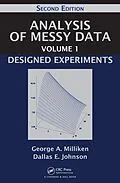A bestseller for nearly 25 years, Analysis of Messy Data, Volume 1: Designed Experiments helps applied statisticians and researchers analyze the kinds of data sets encountered in the real world. Written by two long-time researchers and professors, this second edition has been fully updated to reflect the many developments that have occurred since t
Autorentext
George A. Milliken, Dallas E. Johnson
Inhalt
The Simplest Case: One-Way Treatment Structure in a Completely Randomized Design Structure with Homogeneous Errors. One-Way Treatment Structure in a Completely Randomized Design Structure with Heterogeneous Errors. Simultaneous Inference Procedures and Multiple Comparisons. Basics for Designing Experiments. Multilevel Designs: Split-Plots, Strip-Plots, Repeated Measures, and Combinations. Matrix Form of the Model. Balanced Two-Way Treatment Structures. Case Study: Complete Analyses of Balanced Two-Way Experiments. Using the Means Model to Analyze Balanced Two-Way Treatment Structures with Unequal Subclass Numbers. Using the Effects Model to Analyze Balanced Two-Way Treatment Structures with Unequal Subclass Numbers. Analyzing Large Balanced Two-Way Experiments Having Unequal Subclass Numbers. Case Study: Balanced Two-Way Treatment Structure with Unequal Subclass Numbers. Using the Means Model to Analyze Two-Way Treatment Structures with Missing Treatment Combinations. Using the Effects Model to Analyze Two-Way Treatment Structures with Missing Treatment Combinations. Case Study: Two-Way Treatment Structure with Missing Treatment Combinations. Analyzing Three-Way and Higher-Order Treatment Structures. Case Study: Three-Way Treatment Structure with Many Missing Treatment Combinations. Random Effects Models and Variance Components. Methods for Estimating Variance Components. Methods for Making Inferences about Variance Components. Case Study: Analysis of a Random Effects Model. Analysis of Mixed Models. Case Studies of a Mixed Model. Methods for Analyzing Split-Plot Type Designs. Methods for Analyzing Strip-Plot Type Designs. Methods for Analyzing Repeated Measures Experiments. Analysis of Repeated Measures Experiments When the Ideal Conditions Are Not Satisfied. Case Studies: Complex Examples Having Repeated Measures. Analysis of Crossover Designs. Analysis of Nested Designs. Appendix. Index.
